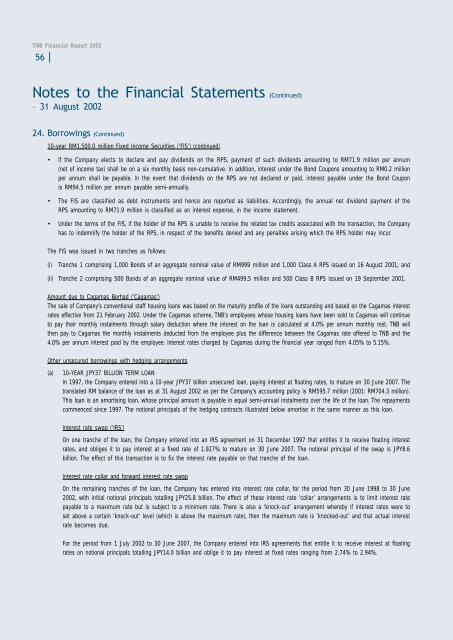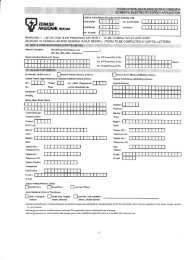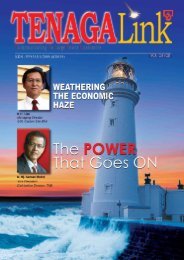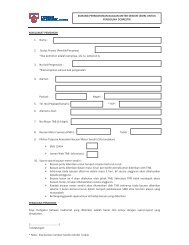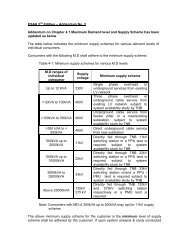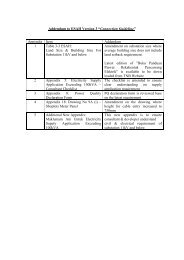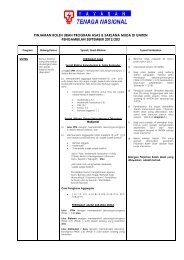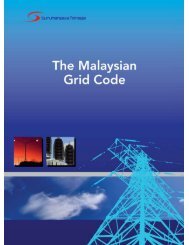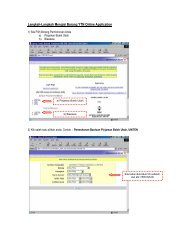Download - Tenaga Nasional Berhad
Download - Tenaga Nasional Berhad
Download - Tenaga Nasional Berhad
Create successful ePaper yourself
Turn your PDF publications into a flip-book with our unique Google optimized e-Paper software.
TNB Financial Report 2002<br />
56<br />
Notes to the Financial Statements (Continued)<br />
– 31 August 2002<br />
24. Borrowings (Continued)<br />
10-year RM1,500.0 million Fixed Income Securities (‘FIS’) (continued)<br />
• If the Company elects to declare and pay dividends on the RPS, payment of such dividends amounting to RM71.9 million per annum<br />
(net of income tax) shall be on a six monthly basis non-cumulative. In addition, interest under the Bond Coupons amounting to RM0.2 million<br />
per annum shall be payable. In the event that dividends on the RPS are not declared or paid, interest payable under the Bond Coupon<br />
is RM94.5 million per annum payable semi-annually.<br />
• The FIS are classified as debt instruments and hence are reported as liabilities. Accordingly, the annual net dividend payment of the<br />
RPS amounting to RM71.9 million is classified as an interest expense, in the income statement.<br />
• Under the terms of the FIS, if the holder of the RPS is unable to receive the related tax credits associated with the transaction, the Company<br />
has to indemnify the holder of the RPS, in respect of the benefits denied and any penalties arising which the RPS holder may incur.<br />
The FIS was issued in two tranches as follows:<br />
(i)<br />
Tranche 1 comprising 1,000 Bonds of an aggregate nominal value of RM999 million and 1,000 Class A RPS issued on 16 August 2001; and<br />
(ii) Tranche 2 comprising 500 Bonds of an aggregate nominal value of RM499.5 million and 500 Class B RPS issued on 19 September 2001.<br />
Amount due to Cagamas <strong>Berhad</strong> (‘Cagamas’)<br />
The sale of Company’s conventional staff housing loans was based on the maturity profile of the loans outstanding and based on the Cagamas interest<br />
rates effective from 21 February 2002. Under the Cagamas scheme, TNB’s employees whose housing loans have been sold to Cagamas will continue<br />
to pay their monthly instalments through salary deduction where the interest on the loan is calculated at 4.0% per annum monthly rest. TNB will<br />
then pay to Cagamas the monthly instalments deducted from the employee plus the difference between the Cagamas rate offered to TNB and the<br />
4.0% per annum interest paid by the employee. Interest rates charged by Cagamas during the financial year ranged from 4.05% to 5.15%.<br />
Other unsecured borrowings with hedging arrangements<br />
(a)<br />
10-YEAR JPY37 BILLION TERM LOAN<br />
In 1997, the Company entered into a 10-year JPY37 billion unsecured loan, paying interest at floating rates, to mature on 30 June 2007. The<br />
translated RM balance of the loan as at 31 August 2002 as per the Company’s accounting policy is RM595.7 million (2001: RM704.3 million).<br />
This loan is an amortising loan, whose principal amount is payable in equal semi-annual instalments over the life of the loan. The repayments<br />
commenced since 1997. The notional principals of the hedging contracts illustrated below amortise in the same manner as this loan.<br />
Interest rate swap (‘IRS’)<br />
On one tranche of the loan, the Company entered into an IRS agreement on 31 December 1997 that entitles it to receive floating interest<br />
rates, and obliges it to pay interest at a fixed rate of 1.927% to mature on 30 June 2007. The notional principal of the swap is JPY8.6<br />
billion. The effect of this transaction is to fix the interest rate payable on that tranche of the loan.<br />
Interest rate collar and forward interest rate swap<br />
On the remaining tranches of the loan, the Company has entered into interest rate collar, for the period from 30 June 1998 to 30 June<br />
2002, with initial notional principals totalling JPY25.8 billion. The effect of these interest rate ‘collar’ arrangements is to limit interest rate<br />
payable to a maximum rate but is subject to a minimum rate. There is also a ‘knock-out’ arrangement whereby if interest rates were to<br />
set above a certain ‘knock-out’ level (which is above the maximum rate), then the maximum rate is ‘knocked-out’ and that actual interest<br />
rate becomes due.<br />
For the period from 1 July 2002 to 30 June 2007, the Company entered into IRS agreements that entitle it to receive interest at floating<br />
rates on notional principals totalling JPY14.0 billion and oblige it to pay interest at fixed rates ranging from 2.74% to 2.94%.


